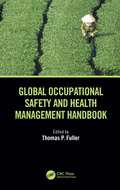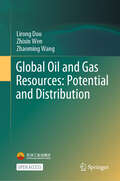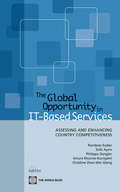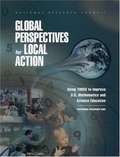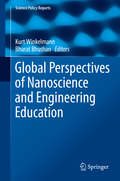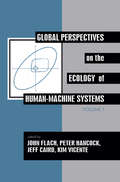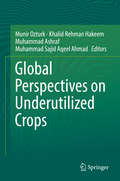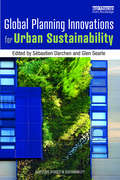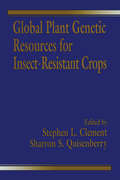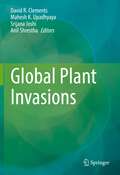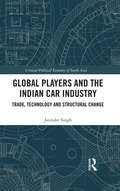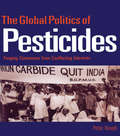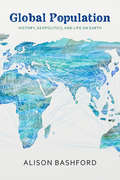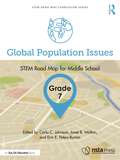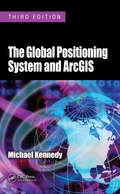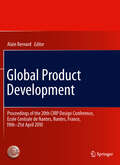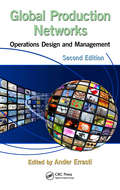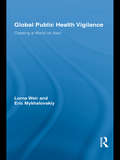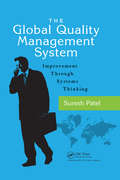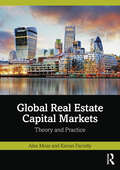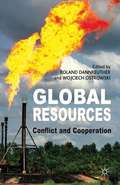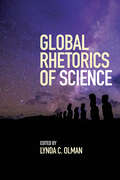- Table View
- List View
Global Occupational Safety and Health Management Handbook
by Thomas FullerThis book was written with the belief that everyone globally has the right to a safe and healthy workplace. An 8-year old carrying bricks in the mid-day sun in Nepal, a pharmaceutical business executive on assignment in Bangladesh, or a mother polishing stone in her home in Tanzania; each has a fundamental right to a workplace free from risk of injury, illness, and death. <p><p> Global Occupational Safety and Health Management Handbook is a broad presentation and discussion of the issues and obstacles facing the Occupational Safety and Health (OSH) profession today in providing safe workplaces globally. Readers can use this book to find resources to assist in the development of their programs and to become informed about the basic structures of international OSH development and governance. Readers can also rely on this book to become more aware of global OSH issues and problems that they may be personally or professionally willing and able to help address. Seasoned OSH professionals can expect to learn about new ways to look at complicated and controversial topics. Young professionals and students can read this book to better understand the important global OSH interrelationships and challenges of the future. <p><p> Features <li>Serves as a one-stop resource for information on important international safety and health topics and issues <li>Provides detailed information about international OSH tripartite, nongovernmental, and professional organizations <li>Describes the various global OSH educational and professional development needs, and international approaches to expanding capacity and awareness of the profession <li>Discusses controversial international OSH working conditions and explains their global impacts
Global Oil and Gas Resources: Potential and Distribution
by Lirong Dou Zhixin Wen Zhaoming WangThis open access book presents the evaluation of undiscovered oil and gas resources and reserves growth in 468 basins around the world, as well as the potential of unconventional recoverable resources of seven types, including shale oil, heavy oil, oil sands, oil shale, shale gas, coalbed methane, and tight gas. The evaluation methods used are innovative, incorporating both conventional and unconventional oil and gas resources evaluation methods that utilize plays as the fundamental evaluation unit based on various exploration maturity levels. The evaluation results obtained independent intellectual property rights and provide an overview of the future exploration potential and prospects of different regions. It is a valuable reference for researchers, practitioners, and students involved in petroleum exploration.
The Global Opportunity in IT-Based Services
by Arturo Muente-Kunigami Philippe Dongier Seth Ayers Christine Zhen-Wei Qiang Randeep SudanRapid advances in information technology (IT) and the resulting global connectivity are fueling dynamic growth in the services sector. Demand for IT and IT-enabled services (ITES) is estimated to represent a $500 billion annual market, of which only about 20 percent has been realized. Thus, this sector is creating new opportunities for economic growth, social empowerment, and grassroots innovation in developing countries. The potential for employment for youth and women is a particular benefit. This book is a practical guide for policy makers aiming to grow their IT services and ITES industries. It defines the development impact of the two industries and then analyzes factors crucial to the competitiveness of a country or location-including skills, cost advantages, infrastructure, and a hospitable business environment. It examines the potential competitiveness of small countries and of least developed countries specifically. This volume presents the Location Readiness Index, a modeling tool developed by McKinsey and Company for the World Bank and the Information Development Program. The index helps countries to identify their areas of relative strengths and weaknesses and to focus their efforts on interventions with the greatest likelihood for success. The book concludes by discussing specific policy options for enabling growth in the IT services and ITES industries.
GLOBAL PERSPECTIVES for LOCAL ACTION: Using TIMSS to Improve U.S. Mathematics and Science Education
by Committee on Science Education K-12The National Academies Press (NAP)--publisher for the National Academies--publishes more than 200 books a year offering the most authoritative views, definitive information, and groundbreaking recommendations on a wide range of topics in science, engineering, and health. Our books are unique in that they are authored by the nation's leading experts in every scientific field.
Global Perspectives for Local Action: Using TIMSS to Improve U.S. Mathematics and Science Education
by National Research CouncilThe Third International Mathematics and Science Study (TIMSS) raised the alarm about U.S. mathematics and science education. Most Americans are now aware that U.S. students lag behind their peers in other developed nations. In one state, the legislature reacted by lengthening the school year, assuming that more time on academic content would boost student performance. Some educators have fixed the blame on the mathematics and science curricula typically used in U.S. schools.Does the problem lie in the curricula, instruction, or the system of support available to teachers? This book presents the first comprehensive analysis of TIMSS study--a half-million students from 15,000 schools around the world. It presents detailed reports on three major aspects of education, including curriculum issues, teaching practices, and school support.
Global Perspectives of Nanoscience and Engineering Education
by Kurt Winkelmann Bharat BhushanThis book presents the perspectives of nanotechnology educators from around the world. Experts present the pressing challenges of teaching nanoscience and engineering to students in all levels of education, postsecondary and informal environments. The book was inspired by the 2014 NSF workshop for Nanoscience and Engineering Education. Since nanotechnology is a relatively new field, authors present recommendations for designing nanotechnology education programs. The chapters describe methods to teach specific topics, such as probe microscopy, size and scale, and nanomaterial safety, in classrooms around the world. Other chapters describe the ways that organizations like NNIN and the NISE Network have influenced informal nanotechnology education. Information technology plays a growing role in all types of education and several chapters are devoted to describing ways how educators can use online curricula for teaching nanotechnology to students from preschool to graduate school.
Global Perspectives on Archaeological Field Schools
by Harold MytumArchaeological field schools, notably in North America but also across the world, are seminal student experiences. They are also important vehicles by which research students and academic staff carry out fieldwork research, often away from the environs of their home institution. Field schools are teaching and research projects, but they also take place within a contemporary local context. This is the first ever collection of studies examining the tensions between teaching, research and local socio-cultural conditions, and explores the range of experiences associated with field schools. It will be of interest to all those wishing to attend a field school, whether as student or junior staff member, and for novice and experienced field school directors who can gain fresh insights from others' experiences.
Global Perspectives on the Ecology of Human-Machine Systems (Resources for Ecological Psychology Series)
by John Flach, Peter Hancock, Jeff Caird and Kim VicenteThere is a growing consensus in the human factors/ergonomics community that human factors research has had little impact on significant applied problems. Some have suggested that the problem lies in the fact that much HF/E research has been based on the wrong type of psychology, an information processing view of psychology that is reductionistic and context-free. Ecological psychology offers a viable alternative, presenting a richer view of human behavior that is holistic and contextualized. The papers presented in these two volumes show the conceptual impact that ecological psychology can have on HF/E, as well as presenting a number of specific examples illustrating the ecological approach to human-machine systems. It is the first collection of papers that explicitly draws a connection between these two fields. While work in this area is only just beginning, the evidence available suggests that taking an ecological approach to human factors/ergonomics helps bridge the existing gap between basic research and applied problems.
Global Perspectives on Underutilized Crops
by Muhammad Sajid Aqeel Ahmad Muhammad Ashraf Khalid Rehman Hakeem Munir OzturkIncrease in world population, extreme weather conditions, decrease in fresh water supplies, and changes of dietary habits are major issues that affect global food security. We are expected to face the challenges of land use by 2050 because population will reach 9 billion while agricultural productivity losses are expected due to overuse of lands. How can we feed the next generations in a manner that respects our finite natural resources? Managing our resources in a sustainable way have only begun for selected crops. Much remains to be done to increase food yield. Cropping practices capable of sustainable production need to be elaborated, especially in fragile ecosystems. Typical applications will include the improvement and use of genetic resources; crop management and diversification; diffusion of improved varieties; development of cropping systems; sustainable cropping systems for areas prone to environmental degradation; use of agro-ecological data for crop production forecasting; and networks for regional coordination, and data exchange. The impetus behind this book is to bring attention to a cropping system that bears direct relevance to sustainable agriculture and food security. “Underutilized” crops are found in numerous agricultural ecosystems and often survive mainly in marginal areas. It is timely to review their status because, in recent decades, scientific and economic interests have emerged which focus on lesser-known cultivated species. Underutilized crops have a great potential to alleviate hunger directly, through increasing food production in challenging environments where major crops are severely limited.“Global Perspectives on Underutilized Crops” is therefore topical and highlights the unmet agricultural challenges that we face today. This book is an important resource for students and researchers of crop science and agricultural policy makers.
Global Planning Innovations for Urban Sustainability (Routledge Studies in Sustainability)
by Sébastien Darchen Glen SearleAs the world becomes more urbanised, solutions are required to solve current challenges for three arenas of sustainability: social sustainability, environmental sustainability and urban economic sustainability. This edited volume interrogates innovative solutions for sustainability in cities around the world. The book draws on a group of 12 international case studies, including Vancouver and Calgary in Canada, San Francisco and Los Angeles in the US (North America), Yogyakarta in Indonesia, Seoul in Korea (South-East Asia), Medellin in Colombia (South America), Helsinki in Finland, Freiburg in Germany and Seville in Spain (Europe). Each case study provides key facts about the city, presents the particular urban sustainability challenge and the planning innovation process and examines what trade-offs were made between social, environmental and economic sustainability. Importantly, the book analyses to what extent these planning innovations can be translated from one context to another. This book will be essential reading to students, academics and practitioners of urban planning, urban sustainability, urban geography, architecture, urban design, environmental sciences, urban studies and politics.
Global Plant Genetic Resources for Insect-Resistant Crops
by Stephen L. ClementAn excellent reference book for plant breeders and entomologists, Global Plant Genetic Resources for Insect-Resistant Crops combines germplasm preservation with use in insect-resistant crop development and basic research. The contributions of the authors represent the efforts, cooperation, and understanding of world leaders in the conservation and use of global plant genetic resources for sustainable agricultural production. Concepts addressed include dependency of modern agriculture on chemical pest control and applications of biotechnology in use of natural plant genes for insect-resistant crops. Marketing Class Code: 1E, 1G, 9C
Global Plant Invasions
by David R. Clements Mahesh K. Upadhyaya Srijana Joshi Anil ShresthaInvasive species have inspired concern for many reasons, including economic and environmental impacts in specific jurisdictions within particular countries. However, it is apparent that for some invasive plant species, political borders offer only weak barriers because these species have succeeded in invading many countries, emerging as threats at a global level. With this level of threat, a number of books on invasive plants and invasive species in general have been published in recent years, but none explicitly provides “global” coverage, perhaps because it is only recently that the full geographical, economic and environmental implications of widespread spread and adaptive nature of these particular invasive plants have been recognized.We plan to make this volume unique by profiling plant invasions in explicitly geographical contexts; on the world continents (Chapters 5-11), as well as islands (Chapter 12) and mountains (Chapter 13). This global approach is supported by an overview of invasion biology and recent advances (Chapter 1) and how different communities differ in invasibility (Chapter 2). Global factors influencing invasion are introduced in Chapter 3 (globalized trade) and Chapter 4 (climate change). Key species are profiled through geographic treatments, continent by continent (Chapters 5-11), and for islands (Chapter 12) and mountains (Chapter 13). The impact of invasive plants is highlighted in Chapter 14, both in biotic and economic terms, partly to counter the tendency for the young field of invasion biology to rely too much on anecdotal evidence. This chapters is also designed to bring home the message that these are serious problems that must be dealt with, as covered in the subsequent chapters. The book concludes with three chapters casting light on solutions to the many problems described in the rest of the volume. Chapter 15 features new, innovative technologies that are being developed to monitor and manage invasive plants, and Chapter 16 presents comprehensive strategies for public education and implementation of management on local and global scales. Chapter 17 describes different future scenarios depending on current trends in plant invasion and its management, just as climate change predictions employ various scenarios to project the future. The future is very much up to us, as humanity grapples with the question of how best to strategically meet the problems of global invasive plant problems that we ourselves have created that is further challenged by a changing climate.We are confident that this book will be of interest to invasion biologists, resource managers, and the legion of others who must deal with these invasive plants across the globe on a daily basis.
Global Players and the Indian Car Industry: Trade, Technology and Structural Change (Critical Political Economy of South Asia)
by Jatinder SinghThis book is one of the first critical analyses of the automobile industry in India. It studies the sector in general and the passenger car industry in particular, and provides valuable insights into the operation of Foreign Direct Investment (FDI) companies in a technology-intensive industry under changing economic regimes. The volume underlines the influence of the changing nature of foreign investment, the impact of economic reforms, technology regimes and industrial policy on growth, structural changes and development. It offers a detailed account of the trade performance of manufacturers in India’s passenger car industry. It also looks at successful cases to draw policy lessons towards encouraging quality FDI and developing India as a base for world production. A useful addition to industry studies in India, this book with its wide coverage and contemporary analyses will interest scholars and researchers of economics, Indian economy and industrial policy, industrial economics, automobile industry and manufacturing sector, development economics and international economics. It will also appeal to policymakers, practitioners and industrial associations.
The Global Politics of Pesticides: Forging consensus from conflicting interests (International Environmental Governance Set Ser.)
by Peter HoughThe Global Politics of Pesticides explores the varied, and often conflicting, interests involved in the formulation of international policies on chemical pesticide manufacture and use in each of the main areas of environmental pollution, trade, development, public health, food security, biotechnology and industrial safety and explains why some aspects of pesticide use are subject to strict international guidelines whilst others are not. The book breaks new ground in objectively examining the competing viewpoints of food producers and other pesticide users, the chemical industry, health officials, traders, environmental/consumer pressure groups and the public. It also considers how international regulation can occur in spite of the fundamental differences of opinion and seemingly opposing interests held by the key actors.
Global Population: History, Geopolitics, and Life on Earth (Columbia Studies in International and Global History)
by Alison BashfordConcern about the size of the world's population did not begin with the "population bomb" in 1968. It arose in the aftermath of World War I and was understood as an issue with far-reaching ecological, agricultural, economic, and geopolitical consequences. The world population problem concerned the fertility of soil as much as the fertility of women, always involving both "earth" and "life."Global Population traces the idea of a world population problem as it evolved from the 1920s through the 1960s. The growth and distribution of the human population over the planet's surface came deeply to shape the characterization of "civilizations" with different standards of living. It forged the very ideas of development, demographically defined three worlds, and, for some, an aspirational "one world."Drawing on international conference transcripts and personal and organizational archives, this book reconstructs the twentieth-century population problem in terms of migration, colonial expansion, globalization, and world food plans. Population was a problem in which international relations and intimate relations were one. Global Population ultimately shows how a geopolitical problem about sovereignty over land morphed into a biopolitical solution, entailing sovereignty over one's person.
Global Population: History, Geopolitics, and Life on Earth
by Alison BashfordConcern about the size of the world's population did not begin with the "population bomb" in 1968. It arose in the aftermath of World War I and was understood as an issue with far-reaching ecological, agricultural, economic, and geopolitical consequences. The world population problem concerned the fertility of soil as much as the fertility of women, always involving both "earth" and "life." Global Population traces the idea of a world population problem as it evolved from the 1920s through the 1960s. The growth and distribution of the human population over the planet's surface came deeply to shape the characterization of "civilizations" with different standards of living. It forged the very ideas of development, demographically defined three worlds, and, for some, an aspirational "one world." Drawing on international conference transcripts and personal and organizational archives, this book reconstructs the twentieth-century population problem in terms of migration, colonial expansion, globalization, and world food plans. Population was a problem in which international relations and intimate relations were one. Global Population ultimately shows how a geopolitical problem about sovereignty over land morphed into a biopolitical solution, entailing sovereignty over one's person.
Global Population Issues, Grade 7: STEM Road Map for Middle School (STEM Road Map Curriculum Series)
by Carla C. Johnson Janet B. Walton Erin E. Peters-BurtonWhat if you could challenge your seventh-grade students to explore mathematical principles as well as global population issues as they consider population density? With this volume in the STEM Road Map Curriculum Series, you can! Global Population Issues outlines a journey that will steer your students toward authentic problem solving while grounding them in integrated STEM disciplines. Like the other volumes in the series, this book is designed to meet the growing need to infuse real-world learning into K–12 classrooms. This interdisciplinary, four-lesson module uses project- and problem-based learning to help students to devise a model for counting populations of a given species on Earth and develop a formal presentation of their models for consideration by a panel of experts. Students will examine species’ ecosystems, explore global populations with an economic and geographical lens, take on the role of an urban planner to develop a megacity that incorporates what they have researched and learned about the consequences of population density and overpopulation, and share literature relevant to their applied species model. To support this goal, students will do the following: · Explore how to gather information about a population and make valid generalizations and inferences from this information · Utilize mathematical practices to complete mathematical explorations · Explore the impact of population density on humans and the environment · Communicate learning and experiences about population density and its influence on humans and the environment through various forms of writing, speaking, and analyzing non-fiction text · Explore the historical, social, geographical, and economic factors related to population density The STEM Road Map Curriculum Series is anchored in the Next Generation Science Standards, the Common Core State Standards, and the Framework for 21st Century Learning. In-depth and flexible, Global Population Issues can be used as a whole unit or in part to meet the needs of districts, schools, and teachers who are charting a course toward an integrated STEM approach.
The Global Positioning System and ArcGIS
by Michael KennedySince the publication of the bestselling second edition of The Global Positioning System and GIS, the use of GPS as an input for GIS has evolved from a supporting analysis tool to become an essential part of real-time management tools in wide-ranging fields. Continued technological advances and decreased costs have altered the GPS vendor landscape significantly and opened the door to an array of receiver and software options. Retaining the in-depth description that made the previous edition so popular, The Global Positioning System and ArcGIS, Third Edition has expanded its coverage to review the capabilities and features common to most receivers. While it emphasizes Trimble and Magellan hardware and Trimble TerraSync and ESRI ArcPad software to capture data, the text’s broadened coverage makes it useful with virtually any hardware/software packages, so readers will be able to collect GPS data and install it in ArcGIS—regardless of the data capture mechanism.Covering the latest developments in this emerging field, the third edition has been updated to include: New information on automated data collection Updates to the conversion of GPS data into GIS form with ArcGIS Desktop (v. 9.3) as well as ESRI software An examination of differential correction and improvements in accuracy of collected data Additional emphasis on ArcMap and Pathfinder Office Illustrations using ArcMap to combine GPS data with other data sets including raster DRGs, DOQs, DEMs, and various vector data sets Using a top-down approach, each chapter begins with a theoretical overview followed by self-study exercises and projects that provide step-by-step guidance on applying the concepts using GPS hardware or a PC. The text includes downloadable resources with GPS data sets for exercises in Trimble SSF and ESRI shapefile formats, plus other valuable learning resources.Solutions manual available upon qualified course adoption
Global Product Development: Proceedings of the 20th CIRP Design Conference, Ecole Centrale de Nantes, Nantes, France, 19th-21st April 2010
by Alain BernardThis book of proceedings is the synthesis of all the papers, including keynotes presented during the 20th CIRP Design conference. The book is structured with respect to several topics, in fact the main topics that serve at structuring the program. For each of them, high quality papers are provided. The main topic of the conference was Global Product Development. This includes technical, organizational, informational, theoretical, environmental, performance evaluation, knowledge management, and collaborative aspects. Special sessions were related to innovation, in particular extraction of knowledge from patents.
Global Production Networks: Operations Design and Management, Second Edition
by Ander ErrastiThe phenomenon of globalization has increased in recent decades due to the opening of borders in Eastern Europe and the sudden emergence of other countries in the global trade economy. Yet, the process of becoming global to get access to growing markets or to achieve quality, service, and/or cost advantages from the reconfigured Value Chains is one
Global Public Health Vigilance: Creating a World on Alert (Routledge Studies in Science, Technology and Society)
by Lorna Weir Eric MykhalovskiyGlobal Public Health Vigilance is the first sociological book to investigate recent changes in how global public health authorities imagine and respond to international threats to human health. This book explores a remarkable period of conceptual innovation during which infectious disease, historically the focus of international disease control, was displaced by "international public health emergencies," a concept that brought new responsibilities to public health authorities, helping to shape a new project of global public health security. Drawing on research conducted at the World Health Organization, this book analyzes the formation of a new social apparatus, global public health vigilance, for detecting, responding to and containing international public health emergencies. Between 1995 and 2005 a new form of global health surveillance was invented, international communicable disease control was securitized, and international health law was fundamentally revised. This timely volume raises critical questions about the institutional effects of the concept of emerging infectious diseases, the role of the news media in global health surveillance, the impact of changes in international health law on public health reasoning and practice, and the reconstitution of the World Health Organization as a power beyond national sovereignty and global governance. It initiates a new research agenda for social science research on public health.
The Global Quality Management System: Improvement Through Systems Thinking
by Suresh PatelThe Global Quality Management System: Improvement Through Systems Thinking shows you how to understand and implement a global quality management system (GQMS) to achieve world-class business excellence. It illustrates the business excellence pyramid with the foundation of management systems at the system level, Lean System at the operational level,
Global Real Estate Capital Markets: Theory and Practice
by Alex Moss Kieran FarrellyThis book unravels the complex mechanisms involved in global real estate capital markets, enabling the reader to understand how they have grown and evolved, how they function, what determines market pricing, and how the public and private debt and equity markets are linked to each other.Using their extensive professional experience, the authors combine a structured, rigorous understanding of the theory and academic evidence behind the main concepts with practical examples, applications, case studies, quizzes and online resources. The book will enable readers to understand for example: · Why share prices of real estate companies can differ dramatically from the underlying value of the assets· The differing investment objectives of different categories of investor and how this influences share prices and corporate funding decisions· How sell-side analysts make their recommendations· How buy-side analysts decide which sectors, funds and stocks to allocate capital to· And how ESG considerations are relevant to capital market pricing.The book is designed not just for advanced real estate students, but also for global finance courses, Executive Education short courses and as a primer for new entrants to the sector. It is key reading for the following groups: · Property professionals working for a listed company wanting to understand the relationship between their underlying business and the stock market valuation · Real Estate Private Equity teams looking to understand the valuation disconnect between public and private markets and arbitrage the Parallel Asset Pricing model · Equity/Multi asset/Property analysts/fund managers who need to understand the specific characteristics of real estate vs the other ten equity sectors and understand when to increase and decrease sector weightings.Online materials for this book can be found on the Routledge Resource website at https://resourcecentre.routledge.com/books/9781032288017.
Global Resources
by Roland Dannreuther Wojciech OstrowskiThis EU-funded project examines the dynamics of conflict, collaboration and competition in relation to access to oil, gas and minerals. It involves 12 different institutions from across the EU and examines oil, gas and other minerals - spanning geology, technology studies, sociology, economics and political science.
Global Rhetorics of Science (SUNY series, Studies in Technical Communication)
by Lynda C. OlmanWith this volume, the field of rhetoric of science joins its sister disciplines in history and philosophy in challenging the dominance of Euro-American science as a global epistemology. The discipline of rhetoric understands world-making and community-building as interdependent activities: that is, if we practice science differently, we do politics differently, and vice versa. This wider aperture seems crucial at a time when we are confronted with the limitations of Euro-American science and politics in managing global risks such as pandemics and climate change—particularly in our most vulnerable communities. The contributors to this volume draw on their familiarity with a wide range of global scientific traditions—from Australian Aboriginal ecology to West African medicine to Polynesian navigation science—to suggest possibilities for reconfiguring the relationship between science and politics to better manage global risks. These possibilities should not only inspire scholars in rhetoric and technical communication but should also introduce readers from science and technology studies to some useful new approaches to the problem of decolonizing scenes of scientific practice around the world.
